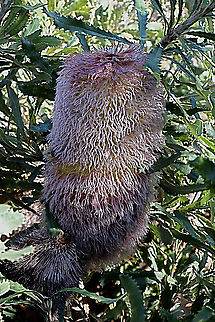
Appearance
''Banksia baueri'' grows as a many-branched spreading shrub reaching 0.5–2 m high, and 3 m wide but does not form a lignotuber. Its bark is thin and grey with long fissures, while new growth is covered in fine pale brown fur. New growth occurs in summer. The leaves are usually narrow egg-shaped with the narrower end towards the base, 40–130 mm long and 5–35 mm wide with serrated edges, tapering to a petiole 5–10 mm long. The inflorescence develops over 5–6 months, and can reach 120–130 mm in diameter, 170 mm high and is borne on a short side branch. The flowers are cream, yellow or brown and hairy, the perianth 50–70 mm long and the pistil 50–58 mm long with a glabrous style. The fruit is a hairy, elliptical follicle 12–17 mm long.
Distribution
''Banksia baueri'' is found in southern Western Australia in three disjunct areas - from Bremer Bay in the east to Jerdacuttup, on the south Stirling Plains, and to the northwest inland between Kweda and Tarin Rock. Plants grow in shrubland or mallee, on flat or genty sloping ground, on white or grey sand or on shallow sand over laterite or quartzite.Habitat
''Banksia baueri'' is found in southern Western Australia in three disjunct areas - from Bremer Bay in the east to Jerdacuttup, on the south Stirling Plains, and to the northwest inland between Kweda and Tarin Rock. Plants grow in shrubland or mallee, on flat or genty sloping ground, on white or grey sand or on shallow sand over laterite or quartzite.A 1985–86 field study in the Fitzgerald River National Park found it to be a main wintertime food source for the nectar-feeding honey possum .Cultural
Its unusual flower spikes are an attractive horticultural feature. It requires well-drained soil in full sun or part shade. Seeds do not require any treatment, and take 20 to 49 days to germinate.References:
Some text fragments are auto parsed from Wikipedia.